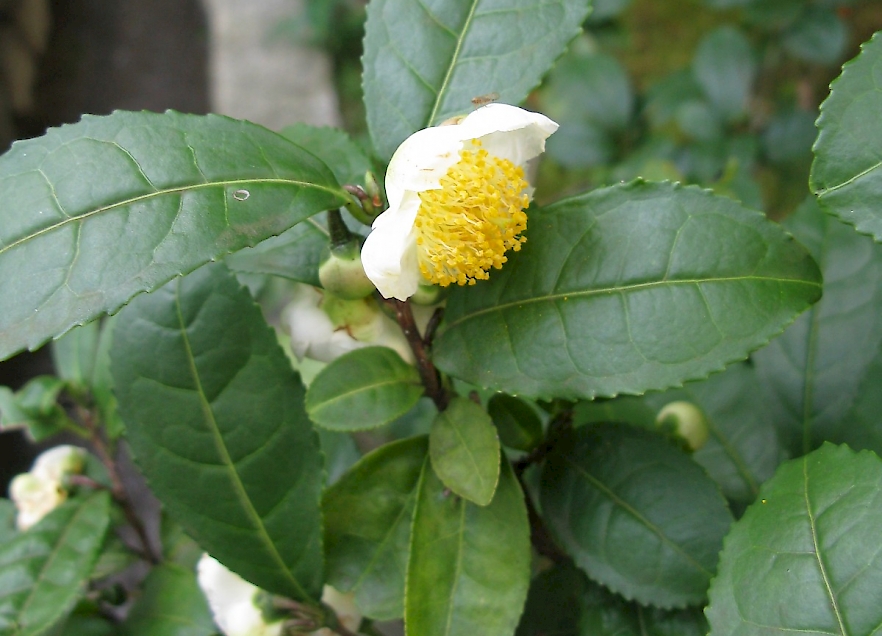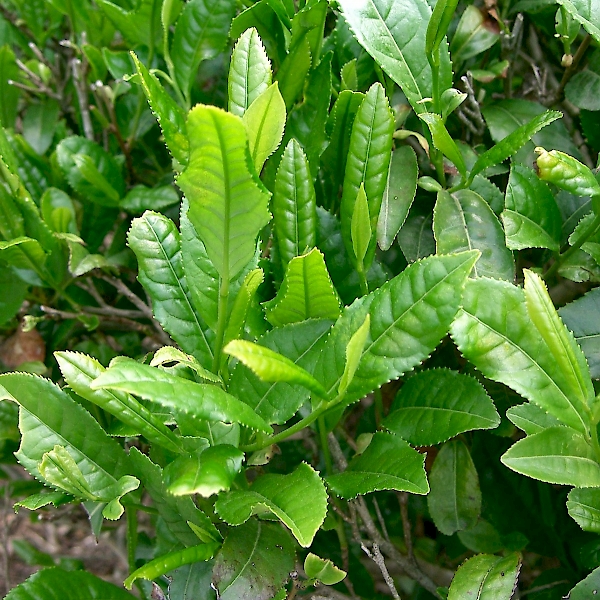Residents of North Florida are no doubt familiar with camellias, the large, glossy-green-leaved shrub that flowers during the cooler seasons. Common varieties include Camellia sasanqua, which blooms from October through December (depending on variety), and Camellia japonica, which blooms January through March. Both make huge, showy blossoms that demand attention, with forms that range from wild-rose-like to stunning geometric formal patterns.
The popularity of these shrubs is not in doubt, but a cousin of theirs takes the prize as one of the most popular plants in the world. Not due to its flowers: this variety of camellia does bloom, but the leaves are most interesting to humans. It is grown in dozens of countries worldwide and global production is estimated at over $17 billion worth of these leaves. The primary product made from this plant is a beverage that is consumed more than any other drink except water. It is, of course, tea.
Camellia sinensis was named by botanist Carl Linnaeus, “Camellia” to honor another botanist, Rev. Georg Kamel, who really had nothing to do with the plant at all, and “sinensis”, which means “from China”. You may be able to deduce where tea is native to.
The tea plant prefers temperatures from 65 to 86 degrees Fahrenheit, doing well in zones 7-9. It can survive freezing or slightly-below-freezing temperatures, though leaves may be damaged by frost. It enjoys moist conditions, needing around 50 inches of rainfall per year. China tea (variety sinensis), which produces smaller, more serrated leaves, prefers more light than Assam types (variety assamica), which have larger, less serrated leaves. Either variety can be grown as a shrub or small tree.
Propagation may be accomplished either by seed or cuttings; cuttings are the preferred method for reproduction, as seeds must be germinated before the seed coat hardens for best results. Caring for tea plants once established involves more frequent but light fertilization, mulching, and regular scouting for pests. Camellia sinensis is susceptible to mites, thrips, scale insects, and aphids, all of which are present in large numbers in our area. Luckily, most of these problems can be solved with an application of either insecticidal soap or horticultural oil, if control is even necessary.
Once a tea plant is large enough to harvest leaves from, it is the new growth which is plucked. The top 2-3 leaves are used either fresh or fermented for a period of time before they are brewed. Green tea comes from the fresh leaves of China type tea plants, while either China or Assam types may be used to make black tea. Black tea leaves are picked, wilted or crushed, and allowed to ferment. Fermentation darkens the leaves and is halted by heating, which also serves to dry the leaves for storage.
For more information on the tea plant, see our EDIS publication on Tea Growing in the Florida Home Landscape.
- The Eastern Lubber Grasshopper - June 5, 2025
- Grass is Growing; Time for Mowing - April 30, 2025
- Variegation, Viruses, and You - June 27, 2024


